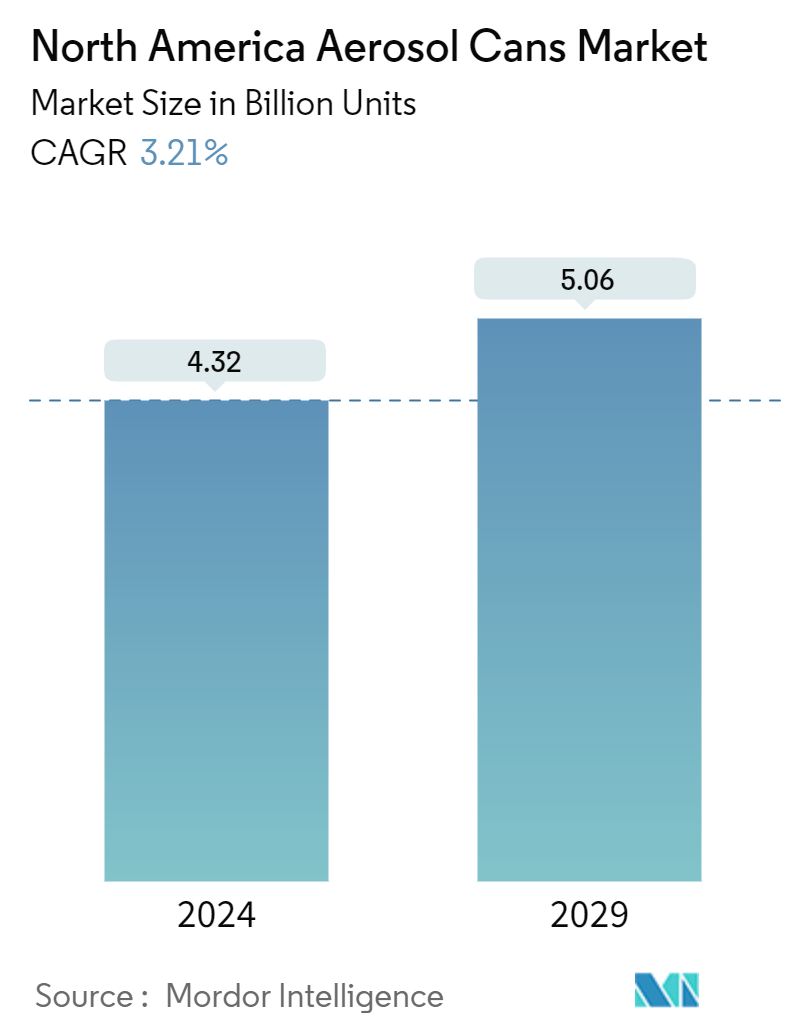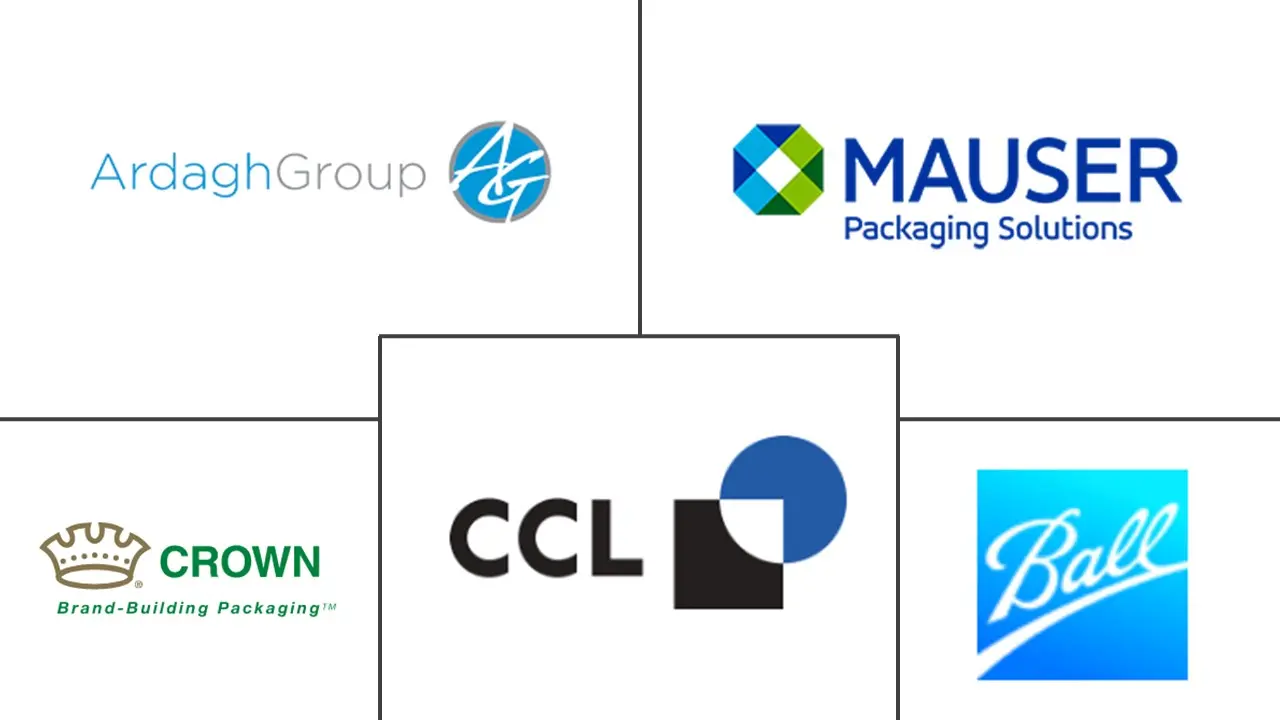Market Size of North America Aerosol Cans Industry

| Study Period | 2019 - 2029 |
| Base Year For Estimation | 2023 |
| Forecast Data Period | 2024 - 2029 |
| Historical Data Period | 2019 - 2022 |
| CAGR (2024 - 2029) | 3.21 % |
| Market Concentration | Low |
Major Players
*Disclaimer: Major Players sorted in no particular order |
North America Aerosol Cans Market Analysis
The North America Aerosol Cans Market size is estimated at 4.32 Billion units in 2024, and is expected to reach 5.06 Billion units by 2029, growing at a CAGR of 3.21% during the forecast period (2024-2029).
- End-use industries, such as cosmetics, personal care, food and beverage, and healthcare, are driving the demand for aerosol cans. The cosmetics and personal care sectors, driven by factors like increasing disposable incomes, changing consumer lifestyles, and a growing demand for items like deodorants and hairsprays, are key drivers of this market's growth.
- In the United States, beauty product vendors are increasingly moving toward standardized packaging solutions. The industry's push for innovation was shown by Aptar Beauty's move in January 2023. The company expanded its sustainable dispensing solutions by introducing two aerosol actuators and a fine mist spray containing up to 46% post-consumer recycled resin (PCR). Aptar Beauty's EuroMist technology, known as North America's leading fine mist spray, works well with many formulas.
- There is a noticeable increase in consumer spending on laundry and cleaning products, showing a higher demand. Metal cans, especially in household sprays, are important for cleaning and disinfecting items like air fresheners and furniture polishes. Procter & Gamble (P&G) witnessed a significant increase in net sales in the United States in 2023, jumping from USD 27.3 billion in 2018 to USD 38.7 billion, marking a strong growth rate of about 12.1%. This rise highlights a significant shift in demand, especially after COVID-19, for P&G's household and personal care products, many of which, including cleaning agents, air fresheners, and unique hygiene products, come in aerosol cans.
- Despite the industry's growth, consumers of cosmetics and personal care products have significant bargaining power, driven by increased competition and many interchangeable products. This often forces producers to lower prices, presenting a challenge for the aerosol can segment. In addition, supply chain disruptions, worsened by rising energy costs, have slowed the growth of the aluminum sector.
- Aluminum aerosol cans are praised for their flexibility, and with a growing focus on recyclable materials, their demand is increasing. The Aluminum Association reports recycling over 40 billion cans annually, showing the industry's commitment to sustainability. The United States could save a significant USD 800 million each year by recycling the aluminum that is currently going to landfills.
- The market's growth is further supported by the proactive strategies of industry associations. The Can Manufacturers Institute (CMI) has set ambitious goals to increase the aluminum beverage can recycling rate in the United States to 70% by 2030, with further goals of 80% by 2040 and over 90% by 2050. These initiatives show the industry's commitment to using aluminum's sustainability.
North America Aerosol Cans Industry Segmentation
Aerosol cans are extensively used as pressurized containers that dispense liquids or powders as a fine spray, mist, or foam when activated. The study tracks the demand for aerosol cans offered by various vendors operating in North America across the end-user industries.
The North American aerosol cans market is segmented by material (aluminum, steel-tinplate, and other materials), end-user industry (cosmetic and personal care, household, pharmaceutical/veterinary, paints, and varnishes, automotive/industrial, and other end-user industries), and country (United States and Canada). The report offers market sizes and forecasts in terms of volume (units) for all the above segments.
| By Material | |
| Aluminium | |
| Steel-Tinplate |
| By End-user Industry | |
| Cosmetic and Personal Care (Deodorants/Antiperspirants, Hairsprays, Hair Mousse, and Others) | |
| Household | |
| Pharmaceutical/Veterinary | |
| Paints and Varnishes | |
| Automotive/Industrial |
| By Country | |
| United States | |
| Canada |
North America Aerosol Cans Market Size Summary
The North American aerosol cans market is experiencing steady growth, driven by increasing demand across various end-use industries such as cosmetics, personal care, food and beverage, and healthcare. The cosmetics and personal care sectors are particularly influential, with rising disposable incomes and evolving consumer lifestyles boosting the demand for products like deodorants and hairsprays. Innovations in packaging, such as Aptar Beauty's introduction of sustainable dispensing solutions, highlight the industry's focus on sustainability and efficiency. The market is also benefiting from the growing consumer spending on cleaning and disinfecting products, with companies like Procter & Gamble reporting significant sales increases. However, challenges such as consumer bargaining power and supply chain disruptions due to rising energy costs pose obstacles to market growth.
The demand for aerosol cans is further supported by their versatility and convenience in various applications, including lubricants, automotive maintenance, and systemic drug delivery. The packaging industry's advancements have enhanced the functionality of aerosol cans, making them a preferred choice for consumers and industries alike. The automotive sector's expansion and the increasing need for vehicle maintenance contribute to the rising demand for aerosol products. Additionally, the focus on recycling and sustainability, particularly with aluminum cans, aligns with industry initiatives to improve recycling rates and reduce environmental impact. Major players in the market, such as Crown Holdings Inc., Ball Corporation, and Ardagh Group SA, are actively engaging in strategic partnerships and innovations to strengthen their market position and drive future growth.
North America Aerosol Cans Market Size - Table of Contents
-
1. MARKET SEGMENTATION
-
1.1 By Material
-
1.1.1 Aluminium
-
1.1.2 Steel-Tinplate
-
-
1.2 By End-user Industry
-
1.2.1 Cosmetic and Personal Care (Deodorants/Antiperspirants, Hairsprays, Hair Mousse, and Others)
-
1.2.2 Household
-
1.2.3 Pharmaceutical/Veterinary
-
1.2.4 Paints and Varnishes
-
1.2.5 Automotive/Industrial
-
-
1.3 By Country
-
1.3.1 United States
-
1.3.2 Canada
-
-
North America Aerosol Cans Market Size FAQs
How big is the North America Aerosol Cans Market?
The North America Aerosol Cans Market size is expected to reach 4.32 billion units in 2024 and grow at a CAGR of 3.21% to reach 5.06 billion units by 2029.
What is the current North America Aerosol Cans Market size?
In 2024, the North America Aerosol Cans Market size is expected to reach 4.32 billion units.

